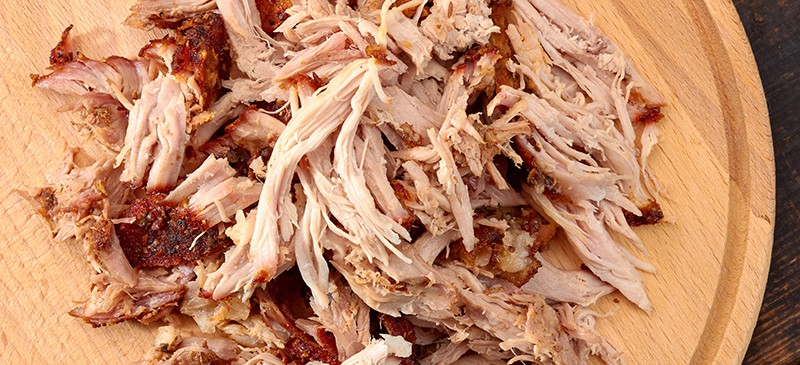
Pork is the most widely eaten meat in the world, making up about 36 percent of meat production worldwide. It’s especially popular in East and Southeast Asia, Europe, Sub-Saharan Africa, North America, South America, and Oceania.
No matter how you think about it, pigs are rather dirty animals. They’re considered the garbage and waste eliminators of the farm, often eating literally anything they can find. This includes not only bugs, insects and whatever leftover scraps they find laying around, but also their own feces, as well as the dead carcasses of sick animals, including their own young.
Just knowing what a pig’s diet is like can explain why the meat of the pig can be not so appetizing to consume. While being ‘”grossed out” may or may not be a valid reason not to eat something, it’s vital to understand a bit more about pork before reaching your own conclusion.
Let’s talk about this popular yet seriously questionable protein source.
Nutrition Facts
A three-ounce serving of cooked ground pork (about 85 grams) contains approximately:
- Calories: 252
- Total Fat: 17.7 g
- Saturated Fat: 6.6 g
- Polyunsaturated Fat: 1.6 g
- Monounsaturated Fat: 7.9 g
- Trans Fat: 0 g
- Protein: 21.8 g
- Sodium: 62 mg (2.7% DV*)
- Selenium: 30.1 mcg (55% DV)
- Thiamine: 0.6 mg (50% DV)
- Zinc: 2.7 mg (25% DV)
- Niacin: 3.6 mg (23% DV)
- Vitamin B12: 0.5 mcg (21% DV)
- Vitamin B6: 0.3 mg (18% DV)
- Riboflavin: 0.2 mg (15% DV)
- Phosphorus: 192 mg (15% DV)
- Pantothenic Acid: 0.4 mg (8% DV)
- Potassium: 308 mg (7% DV)
- Iron: 1.1 mg (6% DV)
- Magnesium: 20.4 mg (5% DV)
*Daily Value: Percentages are based on a diet of 2,000 calories a day.
Potential Benefits
1. Aids Cell Function and Growth
Pork is loaded with B vitamins, and we know B vitamins help convert food to energy and are vital for cell growth and function. Thanks to the B vitamins, pork is also a potential brain-boosting food because thaimine, niacin riboflavin, B6, B12 and pantothenic acid all aid cognitive function.
2. Protects Muscle Mass and Helps Muscle Maintenance
As a high-protein food, pork can help prevent sarcopenia, the condition in which the body loses muscle. It’s also been shown “to facilitate skeletal muscle growth, repair and regeneration during recovery from exercise.”
In fact, a 2022 study published in the International Journal of Environmental Research and Public Health revealed that meat consumption, including pork, “could be an effective post-exercise food that results in favorable muscle protein synthesis and metabolic performance.”
3. May Boost Exercise Performance
We know protein is good for muscles and exercise performance, but protein isn’t the only reason this meat can benefit you while you exercise. It’s also high in taurine, creatine, beta-alanine and other amino acids. These have been found to boost exercise performance in many studies.
The Problems With Pork
1. The Pig’s Problematic Digestive System
There are reasons that the meat of the pig becomes more saturated with toxins than many of its counterpart farm animals. The first reason has to do with the digestive system of a pig.
During the digestive process, animals (including humans) get rid of excess toxins as well as other components of the food eaten that could be dangerous to health. Since the pig’s digestive system operates rather basically, many of these toxins remain in its system to be stored in its more than adequate fatty tissues ready for our consumption.
Another issue with the pig is that it has very few functional sweat glands and can barely sweat at all. Sweat glands are a tool the body uses to be rid of toxins. This leaves more toxins in the pig’s body.
When you consume pork meat, you too get all these toxins that weren’t eliminated from the pig. For instance, there have been examples of pigs and pork products being contaminated with:
In fact, we should all do what we can to eliminate and cut down on toxin exposure. One vital way to do this is by choosing what you eat carefully.
2. Increased Cancer Risk from Bacon and Other Processed Pork
According to the World Health Organization, processed meat like ham, bacon and sausage can cause cancer. The International Agency for Research on Cancer actually classifies processed meat as a carcinogen, something that causes cancer. Researchers found that consuming 50 grams of processed meat each day raises your risk of colorectal cancer by a very significant 18 percent.
Processed meat is considered to be food items like ham, bacon, sausage, hot dogs and some deli meats. Noticing a theme there? Those are mainly pork-derived food products.
How much processed meat is 50 grams? That’s about four strips of bacon.
Maybe you’re thinking that you only eat two pieces of bacon regularly. According to this research, that would likely equate to a 9 percent increase of cancer likelihood.
Unfortunately, pork and processed meat are often consumed by folks following the keto diet, Paleo diet, as well as the Atkins diet, for example. Instead, they should use healthier meat, like beef, lamb, bison or chicken.
3. Swine Flu in Humans
The swine flu is another virus that has made the leap from pig to human. Influenza or flu viruses can be directly transmitted from pigs to humans, from humans to pigs and from humans to humans. Human infection with flu viruses from pigs are most likely when humans are physically close to infected pigs.
According to the Centers for Disease Control and Prevention, H1N1 and H3N2 are swine flu viruses that are “endemic among pig populations in the United States and something that the industry deals with routinely.” Outbreaks can occur year-round. H1N1 has been observed in pig populations since at least 1930, while H3N2 began in the United States around 1998.
According to the CDC, swine flu has not been shown to be transmissible to people through eating properly handled and prepared pork. Properly prepared means cooking pork to an internal temperature of 160 degrees Fahrenheit, which is supposed to kill all viruses and other foodborne pathogens.
4. Trichinosis Dangers
Did you know that pigs carry a variety of parasites in their bodies and meat? Some of these parasites are difficult to kill even when cooking. This is the reason there are so many warnings out there about eating undercooked pork.
READ RELATED: CA Attorney General Bonta’s Wife Appointed to Lead Assembly Committee That Oversees His Budget
One of the biggest concerns with eating pork meat is trichinosis or trichinellosis. This is an infection that humans get from eating undercooked or uncooked pork that contains the larvae of the trichinella worm. In some countries and cultures, they actually consume pork raw.
This worm parasite is very commonly found in pork. When the worm, most often living in cysts in the stomach, opens through stomach acids, its larvae are released into the body of the pig. These new worms make their homes in the muscles of the pig.
Next stop? The unknowing human body that consumes this infected meat flesh.
Similarly to what these worms do to the pig, they can also do to humans. If you eat undercooked or raw pork that contains the parasite, then you are also swallowing trichinella larvae encased in a cyst.
Your digestive juices dissolve the cyst, but that only unleashes the parasite into your insides. The larvae then penetrate your small intestine, where they mature into adult worms and mate. If you’re at this stage of trichinosis, you may experience abdominal pain, diarrhea, fatigue, nausea and vomiting.
Unfortunately, it doesn’t end there. Approximately a week after eating the infected pork, the adult female worms now inside your body produce larvae that enter your bloodstream and eventually burrow into muscle or other tissue. Once this tissue invasion occurs, symptoms of trichinosis include:
- Headache
- High fever
- General weakness
- Muscle pain and tenderness
- Pink eye (conjunctivitis)
- Sensitivity to light
- Swelling of the eyelids or face
While no one particularly wants to consume worms, trichinosis is a serious illness that you should do virtually anything to avoid. Abdominal symptoms can occur one to two days after infection while additional symptoms usually start two to eight weeks after infection.
According to Mayo Clinic, the severity of symptoms typically depends on the number of larvae consumed in the infected meat.
The CDC recommends thorough cooking of pork as well as freezing the pork meat prior to cooking to kill off any worms.
It’s actually been theorized that trichinellosis is the exact cause of Mozart’s rather sudden death at age 35. An American researcher theorized this after studying all the documents recorded the days before, during and after Mozart’s death.
This research published in Archives of Internal Medicine’s June 2001 issue found that Mozart suffered many of the above listed symptoms and that he recorded in his journal the consumption of pork just 44 days before his own death.
5. Pigs Harbor Common Viruses and Parasites
Pigs carry many viruses and parasites with them. Whether by coming in direct contact with them through farms or by eating their meat, we put ourselves at higher risk of getting one of these painful, often debilitating diseases (not to mention put our bodies on toxic overload).
Pigs are primary carriers of:
- Taenia solium tapeworm
- Hepatitis E virus (HEV) — In developed countries, sporadic cases of HEV genotype 3 have occurred in humans after eating uncooked or undercooked pork.
- Porcine reproductive and respiratory syndrome, aka blue-ear pig disease
- Nipah virus
- Menangle virus
- Viruses in the family Paramyxoviridae
Each of these parasites and viruses can lead to serious health problems that can last for years to come.
Factory Farming and Pigs
It’s also important to know about the common conditions of pork raised for consumption. Today, a vast majority of pigs in the United States are raised in factory farms. This means that these pigs never live healthy lives of fresh air and wide-open pastures.
If you’re a pork eater, you should know that it’s very likely that you’re eating the meat of a pig that spent all of its time in a crowded warehouses with no fresh air or exercise, fed a steady diet of harmful drugs to keep the pig breathing as producers make pigs grow faster and fatter. These drugs often cause the pigs to become crippled under their own excessive and unnatural weight gain.
Drug Resistant Bacteria in Pork Chops and Ground Pork
It’s estimated that 70 percent of factory-farmed pigs have pneumonia when they go to the slaughterhouse, according to PETA. Unsightly factory-farm conditions of filth and extreme overcrowding lead pigs to have an extreme likelihood for serious diseases. The conditions are so bad that the only way to keep these pigs barely alive at times is to misuse and overuse antibiotics.
Similarly to humans, pigs are more commonly developing diseases that are resistant to antibiotics. You might like the taste of pork, but do you want to consume a pork product from a pig that had a “superbacteria”?
The bacteria-laden pork story continues. A 2013 Consumer Reports analysis of U.S. pork chops and ground pork samples found widespread (69 percent) presence of a bacteria called yersinia enterocolitica. This bacterium infects about 100,000 Americans a year, especially children, and can cause fever, diarrhea and abdominal pain in humans.
History of Pork and Cultures Who Don’t Eat It
The pig is one of the oldest forms of livestock worldwide. It’s said to have been domesticated as early as 5000 B.C.
When it comes to the beginnings of pork consumption in the U.S., Hernando de Soto is called “the father of the American pork industry.” In 1539, de Soto landed in Florida with 13 pigs in tow, and pork consumption spread and grew from then on in America. Pigs were first commercially slaughtered in Cincinnati, which was nicknamed “Porkopolis.”
Orthodox Jewish Kosher dietary laws and Islamic Halal dietary laws prohibit pork consumption. There are many other religions and cultures that avoid pork as well.
Christian religious denominations that forbid pork consumption include:
- Ethiopian Orthodox
- Hebrew Roots
- Messianic Jews
- Rastafarian
- Seventh-Day Adventists
- United Church of God
Avoiding pork for these groups is based on Leviticus 11, Deuteronomy 14, Isaiah 65 and Isaiah 66.
!function(f,b,e,v,n,t,s)
{if(f.fbq)return;n=f.fbq=function(){n.callMethod?
n.callMethod.apply(n,arguments):n.queue.push(arguments)};
if(!f._fbq)f._fbq=n;n.push=n;n.loaded=!0;n.version=’2.0′;
n.queue=[];t=b.createElement(e);t.async=!0;
t.src=v;s=b.getElementsByTagName(e)[0];
s.parentNode.insertBefore(t,s)}(window, document,’script’,
‘
fbq(‘init’, ‘3475171552810057’);
fbq(‘track’, ‘PageView’);




